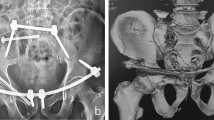Abstracts
Purpose
Plate fixation, the conventional treatment for traumatic symphysis pubis diastasis, carries the risk of extensive exposure, blood loss and postoperative infections. Percutaneous screw fixation is a minimally invasive treatment. The goal of the present study was to compare the outcome of plate fixation and percutaneous screw technique in the treatment of traumatic pubic symphysis diastasis.
Methods
Ninety patients with traumatic symphysis pubis diastasis were treated from January 2003 to December 2009 at two level 1 regional trauma centers. The mean time of follow-up was 21 months (18 to 26). Forty-five patients were treated by percutaneous screw fixation. Forty-five patients were treated by plate and screws fixation. The demographic, distribution of fracture patterns, blood loss, incision length, fixation failure, malunion, revision surgery and functional scores were compared.
Results
Seven cases were lost during follow-up. Demographics (age and gender), fracture classification and Injury Severity Score were comparable in the two groups (P > 0.05). Blood loss and extensive exposure were much less in screw group (P < 0.01). Patients in screw group achieved better functional performance (P = 0.01). There were no significant differences favoring plate fixation in reduction quality (P = 0.32), implant failure (P = 0.39), malunion (P = 0.15), revision surgery rates (P = 0.27), percentage of impotence in the male patients (P = 0.2) and implant removal time (P = 0.12) between the two groups.
Conclusions
Our results indicate that besides lower rate of iatrogenic injuries and better functional outcome, percutaneous screw fixation of the pubic symphysis is as strong as plate fixation.




Similar content being viewed by others
References
Yang NP, Chan CL, Yu IL, Lee CY, Chou P (2010) Estimated prevalence of orthopaedic fractures in Taiwan–a cross-sectional study based on nationwide insurance data. Injury 41(12):1266–1272
Sagi HC, Ordway NR, DiPasquale T (2004) Biomechanical analysis of fixation for vertically unstable sacroiliac dislocations with iliosacral screws and symphyseal plating. J Orthop Trauma 18(3):138–143
Sagi HC, Papp S (2008) Comparative radiographic and clinical outcome of two-hole and multi-hole symphyseal plating. J Orthop Trauma 22(6):373–378
Phieffer LS, Lundberg WP, Templeman DC (2004) Instability of the posterior pelvic ring associated with disruption of the pubic symphysis. Orthop Clin North Am 35(4):445–449
Putnis SE, Pearce R, Wali UJ, Bircher MD, Rickman MS (2011) Open reduction and internal fixation of a traumatic diastasis of the pubic symphysis: one-year radiological and functional outcomes. J Bone Jt Surg Br 93(1):78–84
Mu WD, Wang H, Zhou DS, Yu LZ, Jia TH, Li LX (2009) Computer navigated percutaneous screw fixation for traumatic pubic symphysis diastasis of unstable pelvic ring injuries. Chin Med J (Engl) 122(14):1699–1703
Majeed SA (1989) Grading the outcome of pelvic fractures. J Bone Jt Surg Br 71(2):304–306
Beck M, Krober M, Mittlmeier T (2010) Intraoperative three-dimensional fluoroscopy assessment of iliosacral screws and lumbopelvic implants stabilizing fractures of the os sacrum. Arch Orthop Trauma Surg 130(11):1363–1369
Rosenberger RE, Dolati B, Larndorfer R et al (2010) Accuracy of minimally invasive navigated acetabular and iliosacral fracture stabilization using a targeting and noninvasive registration device. Arch Orthop Trauma Surg 130(2):223–230
Rommens PM (2007) Is there a role for percutaneous pelvic and acetabular reconstruction? Injury 38(4):463–477
Gansslen A, Hufner T, Krettek C (2006) Percutaneous iliosacral screw fixation of unstable pelvic injuries by conventional fluoroscopy. Oper Orthop Traumatol 18(3):225–244
Sciulli RL, Daffner RH, Altman DT, Altman GT, Sewecke JJ (2007) CT-guided iliosacral screw placement: technique and clinical experience. Am J Roentgenol 188(2):W181–W192
Rosenberger RE, Dolati B, Larndorfer R, Blauth M, Krappinger D, Bale RJ (2010) Accuracy of minimally invasive navigated acetabular and iliosacral fracture stabilization using a targeting and noninvasive registration device. Arch Orthop Trauma Surg 130(2):223–230
Walheim GG, Selvik G (1984) Mobility of the pubic symphysis. In vivo measurements with an electromechanic method and a roentgen stereophotogrammetric method. Clin Orthop Relat Res 191:129–135
Walheim G, Olerud S, Ribbe T (1984) Mobility of the pubic symphysis. Measurements by an electromechanical method. Acta Orthop Scand 55(2):203–208
Becker I, Woodley SJ, Stringer MD (2010) The adult human pubic symphysis: a systematic review. J Anat 217(5):475–487
Young JW, Burgess AR, Brumback RJ, Poka A (1986) Pelvic fractures: value of plain radiography in early assessment and management. Radiology 160(2):445–451
Enninghorst N, Toth L, King KL, McDougall D, Mackenzie S, Balogh ZJ (2010) Acute definitive internal fixation of pelvic ring fractures in polytrauma patients: a feasible option. J Trauma 68(4):935–941
Virkus WV, Goldberg SH, Lorenz EP (2008) A comparison of compressive force generation by plating and intramedullary nailing techniques in a transverse diaphyseal humerus fracture model. J Trauma 65(1):103–108
Acknowledgments
We thank our patients for their permission for preparation and submission of this manuscript.
Conflict of interest
The authors declare that they have no conflict of interest. No benefits in any form have been received or will be received from a commercial party related directly or indirectly to the subject of this article.
Author information
Authors and Affiliations
Corresponding authors
Rights and permissions
About this article
Cite this article
Chen, L., Zhang, G., Song, D. et al. A comparison of percutaneous reduction and screw fixation versus open reduction and plate fixation of traumatic symphysis pubis diastasis. Arch Orthop Trauma Surg 132, 265–270 (2012). https://doi.org/10.1007/s00402-011-1414-2
Received:
Published:
Issue Date:
DOI: https://doi.org/10.1007/s00402-011-1414-2




